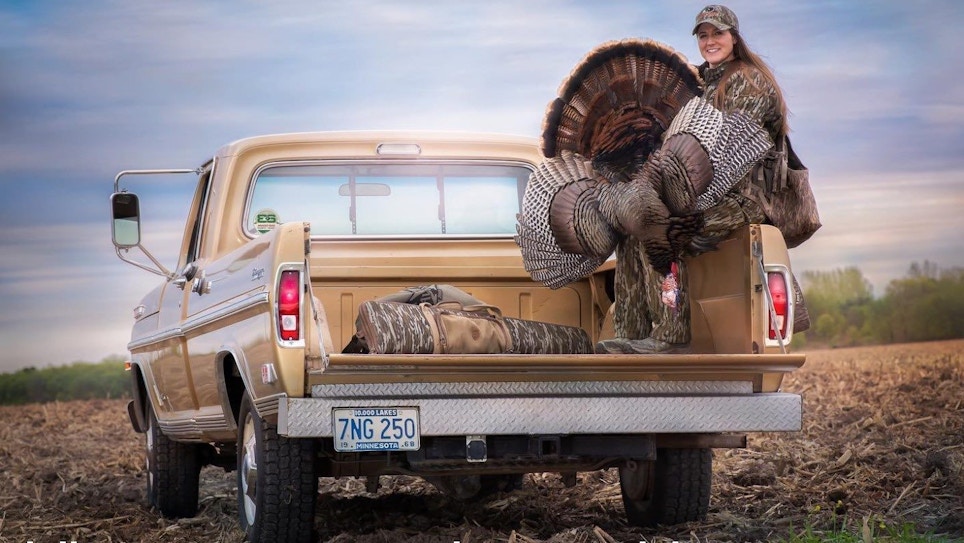
Photo and caption from Mossy Oak Facebook: Amber decided to turkey hunt after all of her kids started hunting. She closed the season with her first longbeard in Minnesota with her husband, Shawn. Congrats, Amber!
When I started turkey hunting back in the mid-1980s, I knew next to nothing. In fact, I wasn’t confident I could distinguish a hen from a jake, and was worried I might pull the trigger on an illegal bird.
True story: My buddy and I crept into a hardwoods in southeast Minnesota before daylight, and soon the valley below us was alive with strange sounds. We had watched a turkey hunting video on a VHS tape before the trip, but nothing in that video matched what we were hearing and experiencing. Could these sounds be wild turkeys? “Can’t be . . . there’s too many,” my buddy whispered as the sky brightened in the east.
An hour later, while we were still sitting at the base of a maple tree, my buddy and I looked at each other in confusion as the strange sounds (gobbling!) were now coming from the green fields behind us, likely not far from our truck. Could these sounds be turkeys? Thinking they had to be birds, we crept toward the field edge and spotted three strutting toms gobbling their heads off.
My first turkey season ended without a shot being fired, but at least my buddy and I learned something about turkey behavior, and we’ve been learning more and more each season since.
Below are four tips to increase the odds of tagging your first tom or jake this spring. Don’t make the mistake of thinking you must know and understand everything about wild turkeys to kill one. And you don’t have to be a champion caller, either.
1. Wait on an Agricultural Field Edge
Turkeys love to pick through cut and picked cornfields for kernels, and they like green fields planted with clover and other products, too. Even if a cornfield was plowed the previous fall after cutting/picking, turkeys will still search through the dirt for kernels, or look for insects and worms. At some point during the day, turkeys will visit the field. Sit butt on the ground with your back against a big tree or a brush pile and wait. Learn where turkeys like to enter and exit a field, then move if necessary to get in better position.
2. Use a Decoy
You don’t need an expensive turkey decoy or several dekes to kill your first tom or jake. Check out the Flextone Thunder Chick Feeder (MSRP: $49.99) for an affordable model that’s easy to carry and looks good (see video below). Place a lone hen decoy at 20 yards so she can be spotted from long range. In addition to visiting fields to feed, a tom or jake can easily spot hens on fields. If a tom or jake stops 10 yards beyond your decoy, it’s still within shotgun range. Tip: Find a long stick and jam it into the ground at 30 yards; this will be your marker for maximum shooting range. (Yes, some gun hunters kill turkeys at ranges twice this far, but unless you’ve dedicated a lot of time at the range testing shotgun chokes, loads and patterns, it’s better to wait for a closer shot.)
3. Learn to Yelp
As I said earlier, you don’t need to be a champion caller to get the attention of a wild turkey. And you don’t need to buy numerous expensive calls. Instead, buy a slate call such as the Primos Ol’ Betsy Turkey Call ($16.99) and learn how to make a series of yelps. This isn’t difficult. After roughing up the slate surface with the included conditioning pad (sandpaper also works), you simply draw nickel-sized ovals on the slate, keeping the striker in contact with the slate as you draw. After a minute or two of practice, you’ll be making yelps that sound decent enough to fool a tom or jake.
The video below shows how to make a series of yelps on a slate call.
4. Be Ready to Shoot, Then Aim for the Base of a Turkey’s Neck
In the video below, Realtree’s David Blanton shows how to hold your shotgun when a turkey has been spotted, or when one has answered your call (i.e. gobbled) and is close but out of sight.
If you’re patient and wait for a shot between 20 and 30 yards, and aim at the base of a turkey’s neck, it won’t matter which shotgun shell you choose (within reason). I’ve killed many turkeys with 2.75-inch No. 4s (i.e. standard loads for pheasants) with my Remington 870 pump shotgun and a standard full choke.





